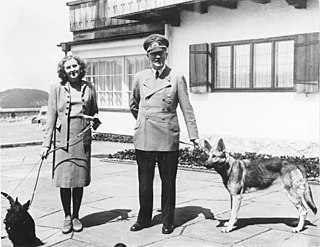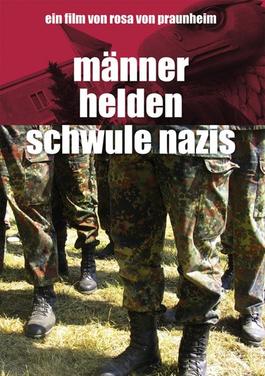
Before 1933, male homosexual acts were illegal in Germany under Paragraph 175 of the German Criminal Code. The law was not consistently enforced, however, and a thriving gay culture existed in major German cities. After the Nazi takeover in 1933, the first homosexual movement's infrastructure of clubs, organizations, and publications was shut down. After the Röhm purge in 1934, persecuting homosexuals became a priority of the Nazi police state. A 1935 revision of Paragraph 175 made it easier to bring criminal charges for homosexual acts, leading to a large increase in arrests and convictions. Persecution peaked in the years prior to World War II and was extended to areas annexed by Germany, including Austria, the Czech lands, and Alsace–Lorraine.

The Night of the Long Knives, also called the Röhm purge or Operation Hummingbird, was a purge that took place in Nazi Germany from 30 June to 2 July 1934. Chancellor Adolf Hitler, urged on by Hermann Göring and Heinrich Himmler, ordered a series of political extrajudicial executions intended to consolidate his power and alleviate the concerns of the German military about the role of Ernst Röhm and the Sturmabteilung (SA), the Nazis' paramilitary organization, known colloquially as "Brownshirts". Nazi propaganda presented the murders as a preventive measure against an alleged imminent coup by the SA under Röhm – the so-called Röhm Putsch.
The Sturmabteilung was the original paramilitary wing of the Nazi Party. It played a significant role in Adolf Hitler's rise to power in the 1920s and 1930s. Its primary purposes were providing protection for Nazi rallies and assemblies, disrupting the meetings of opposing parties, fighting against the paramilitary units of the opposing parties, especially the Roter Frontkämpferbund of the Communist Party of Germany (KPD) and the Reichsbanner Schwarz-Rot-Gold of the Social Democratic Party of Germany (SPD), and intimidating Romani, trade unionists, and especially Jews.

Ernst Julius Günther Röhm was a German military officer and a leading member of the Nazi Party. Initially a close friend and early ally of Adolf Hitler, Röhm was the co-founder and leader of the Sturmabteilung (SA), the Nazi Party's original paramilitary wing, which played a significant role in Adolf Hitler's rise to power. He served as chief of the SA from 1931 until his murder in 1934 during the Night of the Long Knives.

The Reichstag fire was an arson attack on the Reichstag building, home of the German parliament in Berlin, on Monday, 27 February 1933, precisely four weeks after Adolf Hitler was sworn in as Chancellor of Germany. Marinus van der Lubbe, a Dutch council communist, was the alleged culprit; however, Hitler attributed the fire to Communist agitators. He used it as a pretext to claim that Communists were plotting against the German government, and induced President Paul von Hindenburg to issue the Reichstag Fire Decree suspending civil liberties, and pursue a "ruthless confrontation" with the Communists. This made the fire pivotal in the establishment of Nazi Germany.

Kurt Ferdinand Friedrich Hermann von Schleicher was a German general and the penultimate chancellor of Germany during the Weimar Republic. A rival for power with Adolf Hitler, Schleicher was murdered by Hitler's SS during the Night of the Long Knives in 1934.

Horst Ludwig Georg Erich Wessel was a member of the Sturmabteilung (SA), the paramilitary wing of the Nazi Party, who became a propaganda symbol in Nazi Germany following his murder in 1930 by two members of the Communist Party of Germany (KPD). After his death Joseph Goebbels turned him into a martyr for the Nazi Party.

Adolf Hitler's rise to power began in the newly established Weimar Republic in September 1919 when Hitler joined the Deutsche Arbeiterpartei. He rose to a place of prominence in the early years of the party. Being one of its most popular speakers, he was made the party leader after he threatened to otherwise leave.

Edmund Heines was a German Nazi politician and Deputy to Ernst Röhm, the Stabschef of the Sturmabteilung (SA). Heines was one of the earliest members of the Nazi Party and a leading member of the SA in Munich, participating in the Beer Hall Putsch and becoming a notorious enforcer of the party. He held several high-ranking positions in the Nazi administration until he was executed during the Night of the Long Knives in June 1934.

The Scientific-Humanitarian Committee was founded by Magnus Hirschfeld in Berlin in May 1897, to campaign for social recognition of lesbian, gay, bisexual and transgender people, and against their legal persecution. It was the first LGBT rights organization in history. The motto of the organization was "Per scientiam ad justitiam", and the committee included representatives from various professions. The committee's membership peaked at about 700 people. In 1929, Kurt Hiller took over as chairman of the group from Hirschfeld. At its peak, the WhK had branches in approximately 25 cities in Germany, Austria and the Netherlands.

The Pink Swastika: Homosexuality in the Nazi Party is a 1995 pseudohistorical book by Scott Lively and Kevin Abrams. Drawing on Samuel Igra's 1945 book Germany's National Vice, Lively and Abrams argue that the crimes committed by homosexuals in the Nazi Party exceed the persecution of homosexuals in Nazi Germany and that homosexuality contributed to the extreme militarism of Nazi Germany. They contend that only feminine homosexuals were persecuted by the Nazis, while "butch" homosexuals formed the leadership cadre of the Nazi party. Historian Andrew Wackerfuss criticized the book for lack of accuracy and "outright homophobic charges". The claim advanced by Igra, Lively, and Abrams that homosexuals were responsible for Nazi atrocities is rejected by most historians.

Karl Ernst was an SA-Gruppenführer who, from March 1933, was the SA Commander in Berlin. Prior to joining the Nazi Party, he had been a hotel bellhop and a bouncer at gay nightclubs. He was one of the chief participants in the extrajudicial execution of Albrecht Höhler. Ernst was himself extrajudicially executed in the Night of the Long Knives.

The sexuality of Adolf Hitler, dictator of Germany from 1933 to 1945, has long been a matter of historical and scholarly debate, as well as speculation and rumour. There is evidence that he had relationships with a number of women during his lifetime, as well as evidence of his antipathy to homosexuality, and no evidence of homosexual encounters. His name has been linked to a number of possible female lovers, two of whom committed suicide. A third died of complications eight years after a suicide attempt, and a fourth also attempted suicide.
Nazism, the common name in English for National Socialism, is the far-right totalitarian socio-political ideology and practices associated with Adolf Hitler and the Nazi Party (NSDAP) in Germany. During Hitler's rise to power in 1930s Europe, it was frequently referred to as Hitlerism. The later related term "neo-Nazism" is applied to other far-right groups with similar ideas which formed after the Second World War when the Nazi regime collapsed.
Beefsteak Nazi or "Roast-beef Nazi" was a term used in Nazi Germany to describe communists and socialists who joined the Nazi Party. Munich-born American historian Konrad Heiden was one of the first to document this phenomenon in his 1936 book Hitler: A Biography, remarking that in the Sturmabteilung ranks there were "large numbers of Communists and Social Democrats" and that "many of the storm troops were called 'beefsteaks' – brown outside and red within". The switching of political parties was at times so common that SA men would jest that "[i]n our storm troop there are three Nazis, but we shall soon have spewed them out".

Men, Heroes and Gay Nazis is a 2005 German documentary film directed, written and produced by Rosa von Praunheim. The film focuses on gay men who align themselves with hardcore authoritarian views, white power skinheads, and Nazis.

The Brown Book of the Reichstag Fire and Hitler Terror is a book published in Paris, France in August 1933. It was written by an anti-fascist group which included German communist Willi Munzenberg, as well as Hans Siemsen and Gustav Regler. It put forth the theory that Nazis were behind the Reichstag fire of February 27, 1933. According to Spanish novelist Antonio Muñoz Molina it was one of the best selling books of all time.

Allegedly authored in spring 1933 by German national-conservative politician Ernst Oberfohren, the Oberfohren Memorandum advocated that the Reichstag fire of February 27, 1933, had been planned by Hermann Göring and Joseph Goebbels and carried out by a group of Nazi officers. Although rejected as a fabrication by the Nazis, its origins remained mainly unclear until the end of World War II. From 1959 to 1962 author Fritz Tobias published his research in Der Spiegel magazine and in his work The Reichstag Fire: Legend and Truth, asserting that the document was a forgery, produced and circulated in 1933 by German Communist journalist émigrés in France.
Laurie Marhoefer is a historian of queer and trans politics who is employed as the Jon Bridgman Endowed Professor of History at the University of Washington. In January 2021, together with Jennifer V. Evans, they facilitated the Jack and Anita Hess Research Seminar at the United States Holocaust Memorial Museum on LGBTQ+ histories of the Holocaust.

The Röhm scandal resulted from the public disclosure of Nazi politician Ernst Röhm's homosexuality by anti-Nazis in 1931 and 1932. As a result of the scandal, Röhm became the first known homosexual politician.

















